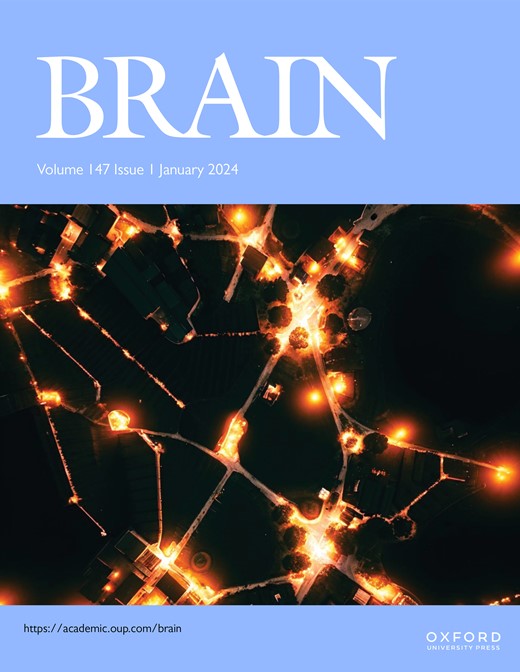Monoallelic de novo variants in DDX17 cause a neurodevelopmental disorder
IF 11.7
1区 医学
Q1 CLINICAL NEUROLOGY
引用次数: 0
Abstract
DDX17 is an RNA helicase shown to be involved in critical processes during the early phases of neuronal differentiation. Globally, we compiled a case-series of 11 patients with neurodevelopmental phenotypes harbouring de novo monoallelic variants in DDX17. All 11 patients in our case series had a neurodevelopmental phenotype, whereby intellectual disability, delayed speech and language, and motor delay predominated. We performed in utero cortical electroporation in the brain of developing mice, assessing axon complexity and outgrowth of electroporated neurons, comparing wild-type and Ddx17 knockdown. We then undertook ex vivo cortical electroporation on neuronal progenitors to quantitatively assess axonal development at a single cell resolution. Mosaic ddx17 crispants and heterozygous knockouts in Xenopus tropicalis were generated for assessment of morphology, behavioural assays, and neuronal outgrowth measurements. We further undertook transcriptomic analysis of neuroblastoma SH-SY5Y cells, to identify differentially expressed genes in DDX17-KD cells compared to controls. Knockdown of Ddx17 in electroporated mouse neurons in vivo showed delayed neuronal migration as well as decreased cortical axon complexity. Mouse primary cortical neurons revealed reduced axon outgrowth upon knockdown of Ddx17 in vitro. The axon outgrowth phenotype was replicated in crispant ddx17 tadpoles and in heterozygotes. Heterozygous tadpoles had clear neurodevelopmental defects and showed an impaired neurobehavioral phenotype. Transcriptomic analysis identified a statistically significant number of differentially expressed genes involved in neurodevelopmental processes in DDX17-KD cells compared to control cells. We have identified potential neurodevelopment disease-causing variants in a gene not previously associated with genetic disease, DDX17. We provide evidence for the role of the gene in neurodevelopment in both mammalian and non-mammalian species and in controlling the expression of key neurodevelopment genes.DDX17的单等位基因从头变异导致神经发育障碍
DDX17 是一种 RNA 螺旋酶,被证明参与了神经元分化早期阶段的关键过程。我们在全球范围内收集了 11 例神经发育表型患者的病例系列,这些患者均携带 DDX17 的从头单倍变异。在我们的病例系列中,所有 11 例患者都有神经发育表型,其中以智力障碍、言语和语言发育迟缓以及运动发育迟缓为主。我们对发育中的小鼠大脑皮层进行了子宫内电穿孔,评估了电穿孔神经元的轴突复杂性和生长情况,并对野生型和 Ddx17 基因敲除进行了比较。然后,我们对神经元祖细胞进行体外皮层电穿孔,以单细胞分辨率定量评估轴突发育情况。我们在热带爪蟾中产生了镶嵌的 ddx17 crispants 和杂合基因敲除,用于评估形态学、行为测定和神经元生长测量。我们进一步对神经母细胞瘤 SH-SY5Y 细胞进行了转录组分析,以确定 DDX17-KD 细胞中与对照组相比有差异的表达基因。在体内电穿孔小鼠神经元中敲除 Ddx17 表明神经元迁移延迟,皮质轴突复杂性降低。在体外敲除 Ddx17 后,小鼠原代皮质神经元的轴突生长减少。轴突生长表型在脆性Ddx17蝌蚪和杂合子中得到了复制。杂合子蝌蚪有明显的神经发育缺陷,并表现出受损的神经行为表型。转录组分析发现,与对照细胞相比,DDX17-KD 细胞中涉及神经发育过程的差异表达基因数量具有统计学意义。我们在一个以前与遗传病无关的基因 DDX17 中发现了潜在的神经发育疾病致病变体。我们提供了证据,证明该基因在哺乳动物和非哺乳动物的神经发育过程中,以及在控制关键神经发育基因的表达中的作用。
本文章由计算机程序翻译,如有差异,请以英文原文为准。
求助全文
约1分钟内获得全文
求助全文
来源期刊

Brain
医学-临床神经学
CiteScore
20.30
自引率
4.10%
发文量
458
审稿时长
3-6 weeks
期刊介绍:
Brain, a journal focused on clinical neurology and translational neuroscience, has been publishing landmark papers since 1878. The journal aims to expand its scope by including studies that shed light on disease mechanisms and conducting innovative clinical trials for brain disorders. With a wide range of topics covered, the Editorial Board represents the international readership and diverse coverage of the journal. Accepted articles are promptly posted online, typically within a few weeks of acceptance. As of 2022, Brain holds an impressive impact factor of 14.5, according to the Journal Citation Reports.
 求助内容:
求助内容: 应助结果提醒方式:
应助结果提醒方式:


